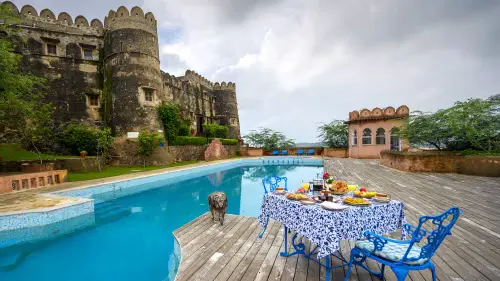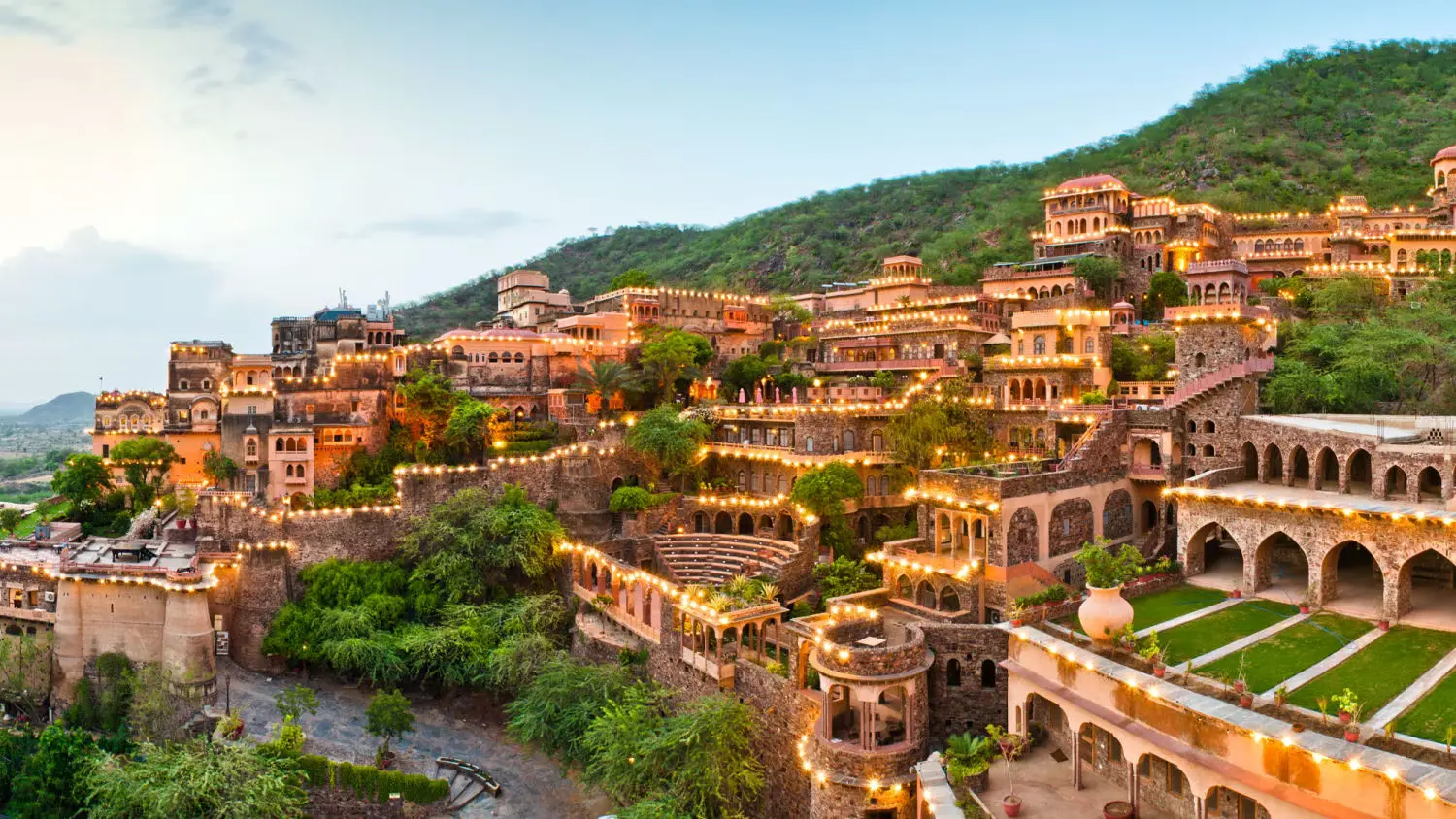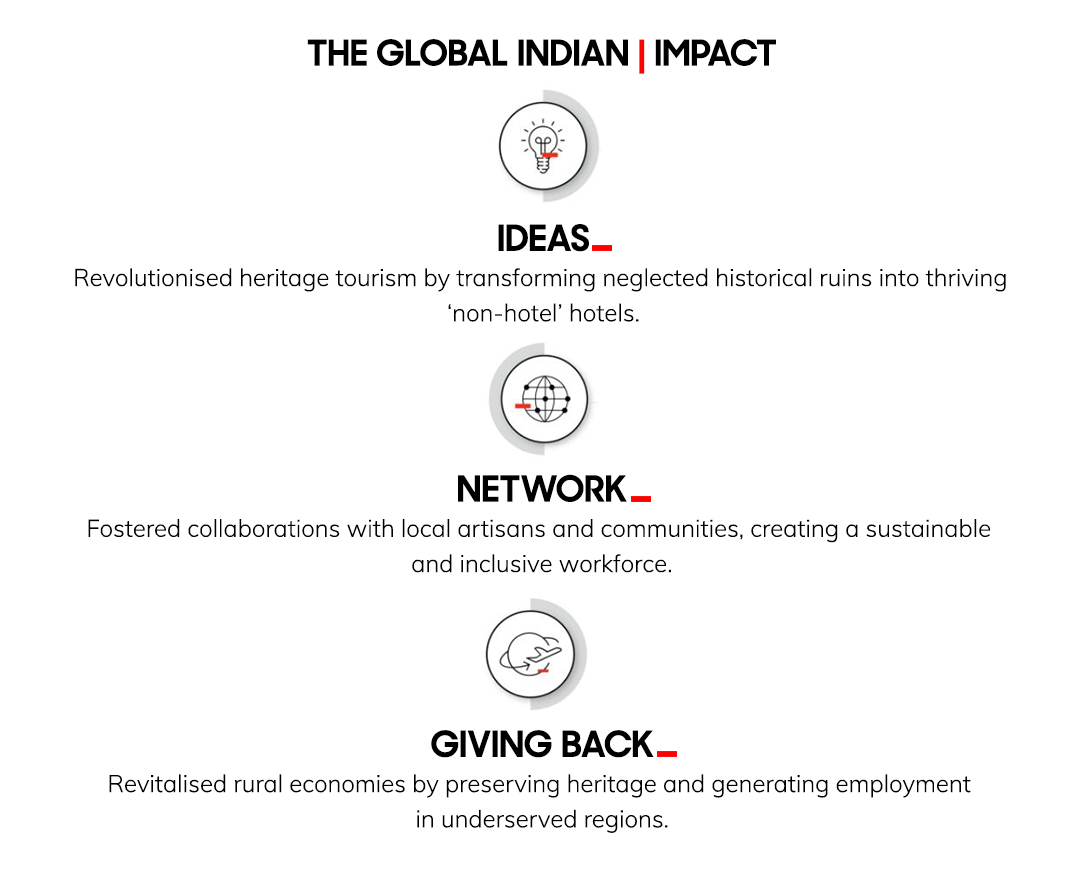(December 1, 2024) Fort-palaces and other dilapidated ruins of historical importance, which had long been neglected, now have a new lease of life led the efforts of historian and author Aman Nath.
Imagine acquiring a 560-year-old medieval fort-palace in 1986, restoring it while preserving its architectural integrity, and converting it into a heritage ‘non-hotel’ hotel—eschewing the usual hospitality norms. Achieving success in just two years instead of the projected eight, all of it self-funded. Expanding to other heritage properties, nearly three decades later, the name Neemrana has become synonymous with historic, heritage properties across India. This, in a nutshell, is the legacy created by Aman Nath, who heads the Neemrana Hotels chain.

Aman Nath
Much has been written about how Nath and his friends who restored the Neemrana Fort-Palace on the Delhi-Jaipur highway. Built in the 15th century, the fort-palace combines Rajput, Sultanate and Mughal architectural styles. In 1986, upon learning that the royal family who owned the fort could no longer maintain it, Nath, along with his two friends Lekha Poddar and OP Jain, decided to acquire the crumbling ruin and restore it into a modern-day heritage hotel. Later, Francis Wacziarg joined Nath in his ventures but sadly passed away. The goal was to showcase India’s culture, heritage, and values to discerning travellers.
Under Nath’s vision and guidance, Neemrana has restored and revitalised over 30 properties across 10 states, transforming them into revenue-generating assets as heritage properties with “zero loans.”

Aman Nath is quite the polymath. Holding a Master’s degree in Medieval Indian History, he has authored 18 books – on Rajasthan, and other notable works such as Horizon: The Tata-India Century (a corporate book marking the centenary of the Tatas, which Ratan Tata called ‘the best book in the whole world’); Dome Over India: Rashtrapati Bhavan, which the Indian President presents every visiting head of State; and several books on Indian art.
As the youngest member of INTACH, the heritage and conservation association, he is credited with heading the restoration of more than 30 heritage properties across India. He has also been awarded the Chevalier de l’Ordre National de la Légion d’Honneur by the President of France for his contributions to heritage conservation, as well as the Lifetime Achievement Awards by the Ministry of Tourism, Government of India, Conde Nast Traveller, and the Lifetime Achievement Award which was recently awarded by the BW Hotelier Group.

Kesroli Fort
History Revisited
In an exclusive interview with Global Indian, Nath, along with his niece Sonavi Kaicker, the CEO, who has been instrumental in guiding the Neemrana team across all 18 Neemrana properties, and growing the business manifold discuss the success of the Neemrana model of hospitality. Nath explains how the preservation of ruins and dilapidated structures while maintaining their historical architecture, allows guests to relive India’s rich culture, heritage, and history. This, he shares, is one of the key visions and USPs at every Neemrana property.
Aman Nath recalls how, in 1986, they began restoring the iconic Neemrana Fort-Palace, which opened its doors in 1991. “The property was restored to blend with the site’s topography, featuring 14 tiered levels cut into the two-billion-year-old Aravalli Hills. It has courtyards, two swimming pools (one temperature-controlled), lush green gardens, an amphitheatre for evening cultural performances, and multiple dining areas, including al-fresco spaces. The restoration process took time, and it took us one year to redo just one wing. The property was opened in 1991 with 15 liveable rooms.” Soon it will have 100 rooms, with lift access to other wings.

Neemrana Fort
Nath emphasises that the Neemrana Fort-Palace is not a typical hotel with carpeted floors, jacuzzis, or luxurious chandeliers. “We call our properties ‘non-hotel’ hotels because none of them were meant to be hotels. Instead, they are structures of historical importance that had fallen to disuse, have been restored with integrity, introducing only basic modern-day amenities to ensure a comfortable stay for discerning travellers.”
The restoration and need-based revitalisation process at Neemrana Fort-Palace continues, with new experiences added regularly. Traditional techniques and materials were used where required while new technologies were introduced when necessary for the restoration. The Kangura (crenellation) motif, replicated from stone, and local artisans were involved in the restoration of cabling, plumbing and other aspects. The Jaalis (fretwork grilles) were made with Berla stone from Rajasthan, and the vaulted roofs were constructed with lime and mortar.
Within Neemrana Fort-Palace, the oldest Jait Mahal(1464CE) houses nine guest rooms named after nine precious stones, while the Hawa Mahal is where evening tea is served. Aam Khas, once the king’s private audience hall, is now an al-fresco dining venue, and the Surya Mahal, originally a 16th-century darbar room where royal ladies observed the all-male court, is now a two-bedroom duplex offering a terrace with a view of the sunset.

Sonavi Kaicker
As early as 2000, the company won the INTACH-SATTE Award for its exemplary restoration and tourism approach. This was followed by a litany of recognitions.
Expanding Horizons with Heritage
The Neemrana vision extends beyond the Fort-Palace to the restoration of other historical ruins, including the 19th-century Tijara Fort-Palace and the 14th-century Hill Fort-Kesroli. Restoring such crumbling ruins has not been without challenges. Aman Nath recalls how the walls of the fort are between 6-16 feet thick, and while lifts have been installed in certain areas, some parts remain accessible only by foot where the stairs have been made friendlier. “You have to want to feel the essence of history, walk into the darbars, and imagine life in the past. If you are not receptive to its history, then this is not for you. We want guests to explore as much of the entire property and savor the countryside as well as its breathtaking views,” says Nath.

Fort Tijara before restoration
The Tijara Fort-Palace and Hill Fort-Kesroli, built in the 14th century by the Yaduvanshi kings, were renovated along similar lines, with the latter being one of the oldest forts where one can wake up in India. Rooms in the Tijara Fort-Palace are named after famous Indian artists, designers, and painters, with artworks adorning each room. Nath has worked with artists from across the country to create several nooks and corners where guests can relish the culture and enjoy the peace and also celebrate and enjoy themselves.
Other Neemrana properties include Deo Bagh (17th century) in Gwalior, The Bungalow on the Beach (17th century) in Tranquebar, Tamil Nadu, and the Baradari Palace (19th century) in Patiala, Punjab. Neemrana properties across Goa, Rishikesh, Kochi, Nainital, and Coonoor offer unique experiences closer to nature, with scenic views of rivers, seas, deserts or hills. Each property retains its original character and construction integrity while being modernised to suit contemporary needs.
Why Neemrana is Special
One of Neemrana’s key strengths is its team—over 65% of which hails from the local regions where the properties are located. Nath knows the names of nearly all of his team members, and Sonavi reveals they have a very low attrition rate. “We treat each member of our team like family,” she says. “We invest in their growth through interest-free loans, education allowances, and medical insurance. They were all retained during the Covid years. They take pride in what they do.”

Fort Tijara post restoration
Neemrana’s success is also due to its approach of being a lean and flexible company, driven by young ideas. “The bottom line is important but never the most important as generating employment in rural areas and restoring India’s heritage remains of paramount importance,” says Sonavi. Neemrana properties are also the NCR’s favourite for destination weddings and conferences, with day tours and lunch packages available for those who want to explore the fort’s history without staying overnight.
The food at Neemrana properties is another key factor in their success. With an emphasis on authentic local cuisine, such as coastal fare in South India and traditional Rajasthani thalis, the menus blend local flavours with international and progressive fusion options to cater to all guests.

Neemrana Hotels continues to pioneer the field of restored heritage properties, offering guests a chance to engage with India’s rich history and architectural beauty while experiencing the timeless charm of heritage travel. They appeal to guests who travel to see the difference.
- Follow Neemrana Hotels on Instagram
Read a similar story of Jonas Masetti, bringing Vedanta to Brazil.




